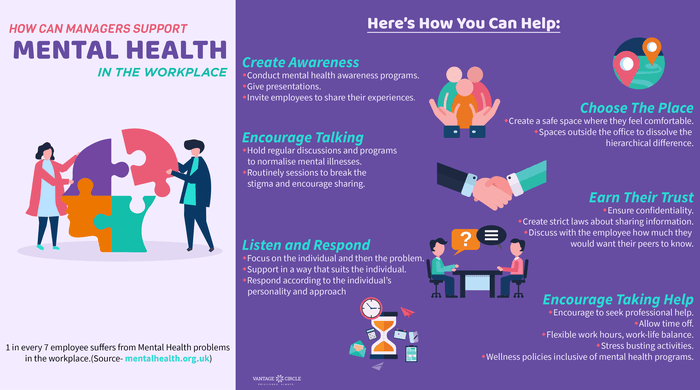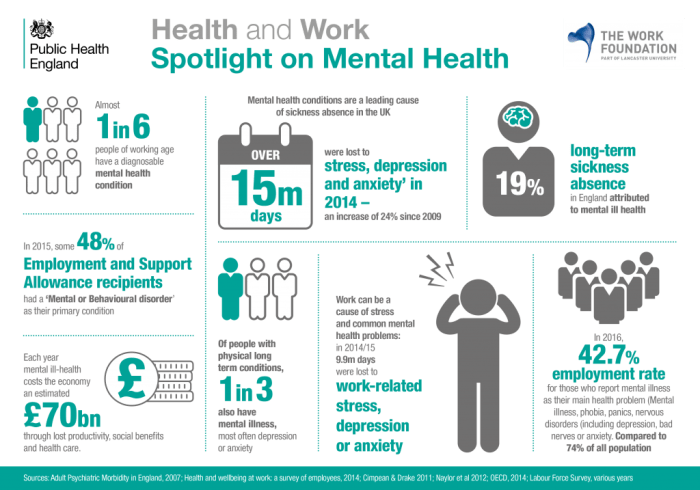Career mental health is no longer a fringe topic; it’s a critical component of overall well-being and a driving force behind workplace success. As the demands of modern work intensify, the connection between mental health and career satisfaction has become undeniable.
This article explores the growing importance of career mental health, common challenges faced by employees, and strategies for promoting a supportive work environment.
The statistics are clear: mental health issues are prevalent in the workforce, impacting productivity, engagement, and retention. This underscores the need for a proactive approach to career mental health, one that addresses both individual and organizational responsibilities.
The Growing Importance of Career Mental Health

The workplace is increasingly recognizing the significance of mental well-being, marking a shift in how we perceive work-life balance. This growing awareness stems from a deeper understanding of the interconnectedness between career satisfaction and mental health. A healthy mind is not just a personal benefit; it’s a crucial factor in driving productivity, creativity, and overall success in the workplace.
The Link Between Career Satisfaction and Mental Well-Being
A fulfilling career significantly contributes to an individual’s overall well-being. When employees feel valued, challenged, and supported, they are more likely to experience higher levels of job satisfaction, leading to improved mental health. Conversely, a stressful or unfulfilling work environment can negatively impact mental well-being, potentially leading to burnout, anxiety, and depression.
Prevalence of Mental Health Issues in the Workforce
Statistics highlight the prevalence of mental health issues in the workforce, emphasizing the need for proactive measures to address these concerns.
- The World Health Organization (WHO) estimates that mental health disorders account for nearly 16% of global disability.
- The American Psychological Association (APA) reports that 80% of employees have experienced at least one work-related stress symptom in the past year.
- The National Institute of Mental Health (NIMH) states that anxiety disorders are the most common mental illness in the United States, affecting 40 million adults each year.
Common Mental Health Challenges in the Workplace

The modern workplace can be a breeding ground for mental health challenges. Employees face a myriad of pressures, from demanding workloads to navigating complex social dynamics. These pressures can contribute to a range of mental health issues, impacting both individual well-being and organizational productivity.
Common Mental Health Conditions in the Workplace
Mental health conditions are prevalent in the workplace, affecting employee performance, engagement, and overall well-being. Understanding the common conditions that employees may face is crucial for creating a supportive and inclusive work environment.
- Anxiety Disorders: Anxiety disorders, characterized by excessive worry and fear, are among the most common mental health conditions in the workplace. They can manifest as generalized anxiety disorder, panic disorder, or social anxiety disorder. Work-related stressors, such as deadlines, performance expectations, and interpersonal conflicts, can trigger or exacerbate these conditions.
- Depression: Depression, a mood disorder characterized by persistent feelings of sadness, hopelessness, and loss of interest, can significantly impact an individual’s ability to function effectively at work. Workplace factors like job insecurity, lack of recognition, and work-life imbalance can contribute to the development or worsening of depressive symptoms.
- Burnout: Burnout, a state of emotional, physical, and mental exhaustion caused by prolonged or excessive stress, is increasingly recognized as a significant workplace issue. It can result from demanding workloads, unrealistic expectations, and a lack of control over one’s work.
Symptoms of burnout include fatigue, cynicism, and a sense of detachment from work.
- Post-Traumatic Stress Disorder (PTSD): PTSD, a mental health condition triggered by a traumatic event, can manifest in the workplace in various ways. Workplace violence, harassment, or witnessing a traumatic incident can contribute to the development of PTSD. Symptoms include intrusive thoughts, nightmares, and avoidance behaviors.
Career mental health is becoming increasingly important as the workplace evolves. Organizations are recognizing the need to support employees’ well-being, and resources like the Cabarrus Health Alliance are playing a crucial role in providing accessible mental health services. By promoting mental health awareness and offering support programs, organizations can create a more positive and productive work environment.
- Stress: Stress is a normal human response to challenging situations. However, chronic stress, which can result from workplace factors like demanding workloads, tight deadlines, and interpersonal conflicts, can have a negative impact on mental health. Long-term stress can lead to anxiety, depression, burnout, and physical health problems.
Maintaining good career mental health is crucial for overall well-being, and finding ways to de-stress is essential. If you’re looking for a great place to let off steam and boost your mood, check out Crunch Fitness Daly City.
With a variety of fitness classes and equipment, it’s a fantastic spot to release tension and feel empowered, which can positively impact your career performance and outlook.
Workplace Stressors and Mental Health
Workplace stressors can significantly contribute to mental health issues. These stressors can be categorized into several key areas:
- Work Overload: Demanding workloads, unrealistic deadlines, and a lack of control over work tasks can lead to stress, anxiety, and burnout. Employees may feel overwhelmed and unable to meet expectations, leading to decreased job satisfaction and increased risk of mental health problems.
- Work-Life Imbalance: A lack of boundaries between work and personal life can lead to stress, anxiety, and burnout. Employees may struggle to balance work responsibilities with family commitments, personal interests, and self-care, leading to feelings of exhaustion and resentment.
- Lack of Support: A lack of support from supervisors, colleagues, or the organization can contribute to stress and mental health issues. Employees may feel isolated, undervalued, and unable to cope with work challenges, leading to decreased morale and engagement.
- Workplace Conflict: Interpersonal conflicts, bullying, and harassment can create a hostile work environment, leading to stress, anxiety, and depression. Employees may feel unsafe, anxious, and unable to perform their jobs effectively, impacting their mental well-being and productivity.
- Job Insecurity: Concerns about job security, layoffs, or downsizing can create a sense of anxiety and stress, impacting employee morale and engagement. This uncertainty can lead to difficulty concentrating, decreased productivity, and increased absenteeism.
Examples of Workplace Environments that Negatively Impact Mental Health
Certain workplace environments can create conditions that negatively impact mental health. Recognizing these environments is essential for promoting a healthy and supportive workplace culture.
- High-Pressure Environments: Workplaces with a constant emphasis on speed, productivity, and competition can create a culture of stress and anxiety. Employees may feel pressured to perform at a high level, leading to burnout, exhaustion, and mental health issues.
- Lack of Flexibility: Rigid work schedules and a lack of flexibility can contribute to work-life imbalance, leading to stress, anxiety, and burnout. Employees may struggle to balance work responsibilities with personal commitments, impacting their well-being and productivity.
- Poor Communication: Lack of clear communication, unclear expectations, and a lack of transparency can create confusion, frustration, and stress. Employees may feel unsure about their roles, responsibilities, and performance expectations, leading to anxiety and decreased job satisfaction.
- Toxic Work Culture: A toxic work culture characterized by bullying, harassment, gossip, and a lack of respect can create a hostile work environment, leading to stress, anxiety, and depression. Employees may feel unsafe, undervalued, and unable to perform their jobs effectively, impacting their mental well-being and productivity.
Strategies for Promoting Career Mental Health

Promoting career mental health involves a multifaceted approach that encompasses individual actions, supportive work environments, and accessible resources. By fostering a culture of well-being, individuals can navigate their careers with greater resilience and satisfaction.
Proactive Steps for Individuals
Taking proactive steps to manage career mental health is essential for individual well-being. Here are some strategies:
| Strategies | Benefits | Examples |
|---|---|---|
| Set Realistic Goals | Reduces pressure and promotes a sense of accomplishment. | Breaking down large projects into smaller, manageable tasks. |
| Practice Mindfulness | Increases self-awareness and reduces stress. | Engaging in meditation, deep breathing exercises, or yoga. |
| Seek Support | Provides a safe space to discuss challenges and access professional guidance. | Connecting with a therapist, counselor, or trusted friend. |
| Prioritize Self-Care | Promotes physical and mental well-being. | Getting adequate sleep, maintaining a healthy diet, and engaging in regular exercise. |
| Develop Healthy Boundaries | Protects personal time and reduces burnout. | Setting limits on work hours, avoiding checking emails after work hours, and taking breaks throughout the day. |
The Role of Employers
Employers play a crucial role in creating a supportive work environment that prioritizes employee mental health. This includes:
“A supportive work environment is one where employees feel valued, respected, and supported in their well-being.”
Here are some key actions employers can take:
- Promote a Culture of Open Communication: Encourage employees to openly discuss mental health concerns without fear of stigma or judgment.
- Offer Flexible Work Arrangements: Provide options for remote work, flexible schedules, and compressed workweeks to accommodate individual needs.
- Provide Mental Health Resources: Offer access to employee assistance programs (EAPs), mental health professionals, and workshops on stress management and well-being.
- Foster a Positive Work Environment: Promote teamwork, collaboration, and a culture of respect and appreciation.
- Encourage Work-Life Balance: Encourage employees to take breaks, utilize vacation time, and prioritize personal well-being.
Resources and Support Systems
Individuals struggling with mental health challenges have access to a variety of resources and support systems. These include:
- Employee Assistance Programs (EAPs): Confidential programs offered by employers that provide counseling, legal advice, and other support services.
- Mental Health Professionals: Therapists, counselors, and psychiatrists who provide diagnosis, treatment, and support for mental health conditions.
- Support Groups: Groups for individuals with shared experiences, providing a sense of community and support.
- Online Resources: Websites, apps, and online communities offering information, support, and resources related to mental health.
The Impact of Career Mental Health on Productivity and Performance

A healthy workforce is a productive workforce. When employees experience positive mental health, they are better equipped to engage in their work, contribute effectively, and achieve organizational goals. Conversely, neglecting career mental health can have detrimental consequences for both individuals and organizations.
Maintaining good career mental health is crucial for success and overall well-being. Finding healthy outlets to manage stress and improve mood can make a significant difference. For those seeking a fitness solution, fitness edge fairfield offers a variety of programs designed to help individuals achieve their fitness goals and enhance their mental well-being.
By prioritizing physical activity and fostering a sense of accomplishment, fitness can positively impact career mental health and lead to a more balanced and fulfilling life.
The Link Between Mental Health and Employee Engagement
Employee engagement is a crucial factor in driving productivity and achieving organizational success. When employees feel valued, supported, and connected to their work, they are more likely to be engaged and contribute their best efforts. Mental well-being plays a significant role in employee engagement.
- Reduced Stress and Anxiety:Employees struggling with mental health issues like stress and anxiety often experience difficulty concentrating, making decisions, and collaborating effectively. This can lead to decreased productivity, poor communication, and missed deadlines.
- Improved Focus and Concentration:When employees prioritize their mental health, they are better able to manage stress, improve their emotional well-being, and enhance their cognitive abilities. This translates into increased focus, concentration, and problem-solving skills, ultimately boosting productivity.
- Enhanced Creativity and Innovation:A positive mental state fosters creativity and innovation. When employees feel supported and empowered, they are more likely to think outside the box, generate new ideas, and contribute to organizational growth.
The Relationship Between Mental Well-being and Employee Retention
Employee retention is a critical factor in organizational stability and success. High turnover rates can lead to increased recruitment costs, decreased productivity, and a loss of institutional knowledge. Mental well-being is directly linked to employee retention.
- Reduced Absenteeism and Presenteeism:Mental health issues can contribute to increased absenteeism and presenteeism, where employees are physically present but not fully engaged or productive due to their mental health. By prioritizing career mental health, organizations can reduce these occurrences and improve overall workforce attendance.
- Improved Employee Morale and Job Satisfaction:When employees feel supported and valued, they are more likely to experience higher morale and job satisfaction. This can lead to increased loyalty, commitment, and a reduced desire to leave the organization.
- Enhanced Sense of Belonging and Support:Organizations that prioritize career mental health create a culture of support and inclusivity. This fosters a sense of belonging and connection among employees, making them feel valued and appreciated, which can contribute to higher retention rates.
Organizational Benefits of Prioritizing Career Mental Health
Organizations that invest in career mental health reap significant benefits in terms of productivity, performance, and overall success.
- Increased Productivity and Efficiency:As discussed earlier, a healthy workforce is a productive workforce. By addressing mental health concerns and promoting well-being, organizations can experience increased productivity, efficiency, and improved performance outcomes.
- Reduced Costs Associated with Mental Health Issues:Neglecting mental health can lead to significant costs for organizations, including absenteeism, presenteeism, healthcare expenses, and turnover. Investing in career mental health programs can help mitigate these costs and create a more sustainable and financially sound organization.
- Improved Employer Brand and Reputation:Organizations that prioritize career mental health demonstrate a commitment to employee well-being and a positive work environment. This can enhance their employer brand, attract top talent, and improve their reputation within the industry.
Future Trends in Career Mental Health

The field of career mental health is constantly evolving, driven by changing societal norms, technological advancements, and a growing awareness of the importance of mental well-being in the workplace. This section explores emerging trends, potential future challenges and opportunities, and a hypothetical scenario illustrating how career mental health practices might evolve in the future.
Emerging Trends in Career Mental Health
The landscape of career mental health is rapidly changing, with several key trends emerging. These trends are shaping how organizations approach mental health in the workplace and how individuals manage their careers.
- Increased Focus on Prevention and Early Intervention: Organizations are increasingly recognizing the importance of preventative measures and early intervention strategies to address mental health concerns. This shift involves proactive initiatives such as mental health awareness campaigns, training programs for managers, and confidential resources for employees.
For example, companies like Google and Adobe offer comprehensive mental health programs, including access to therapists, mindfulness apps, and employee assistance programs.
- Integration of Technology: Technology is playing an increasingly significant role in career mental health. This includes the use of mental health apps, online therapy platforms, and AI-powered tools for mental health assessments and interventions. These technologies offer greater accessibility, convenience, and personalized support for individuals seeking mental health services.
For instance, apps like Headspace and Calm provide guided meditation and mindfulness exercises, while platforms like Talkspace offer online therapy sessions with licensed therapists.
- Focus on Career Development and Meaningful Work: There’s a growing emphasis on aligning career development with personal values and meaning. Individuals are seeking careers that offer purpose, growth opportunities, and a sense of fulfillment. This trend is driving organizations to prioritize employee well-being and create supportive work environments that foster personal and professional growth.
For example, companies like Patagonia and Zappos are known for their commitment to employee well-being and fostering a sense of purpose in the workplace.
- Emphasis on Diversity, Equity, and Inclusion: Recognizing the diverse needs and experiences of employees, organizations are increasingly focusing on creating inclusive work environments that support the mental health of all employees. This includes addressing systemic barriers and promoting mental health resources that are accessible and culturally sensitive.
For example, organizations are implementing diversity and inclusion training programs and creating employee resource groups to support specific communities within the workplace.
Final Conclusion

By prioritizing career mental health, organizations can foster a culture of well-being, enhance employee engagement, and boost productivity. This requires a collaborative effort, with both employers and employees taking ownership of their mental well-being. The future of work hinges on creating environments that support mental health, and this requires a shift in perspective and a commitment to prioritizing well-being alongside performance.
Expert Answers
What are some signs of burnout?
Signs of burnout can include emotional exhaustion, cynicism, decreased productivity, physical symptoms like fatigue and headaches, and difficulty concentrating.
How can I improve my work-life balance?
Setting boundaries, prioritizing tasks, taking regular breaks, and engaging in activities outside of work can help improve work-life balance.
What are some resources available for employees struggling with mental health?
Many organizations offer employee assistance programs (EAPs), mental health resources, and access to therapists or counselors.